How to Measure and Fit Tall Boots
Guide to finding the right type of tall riding boot, sizing and measuring for the perfect fit.
Updated April 1, 2024
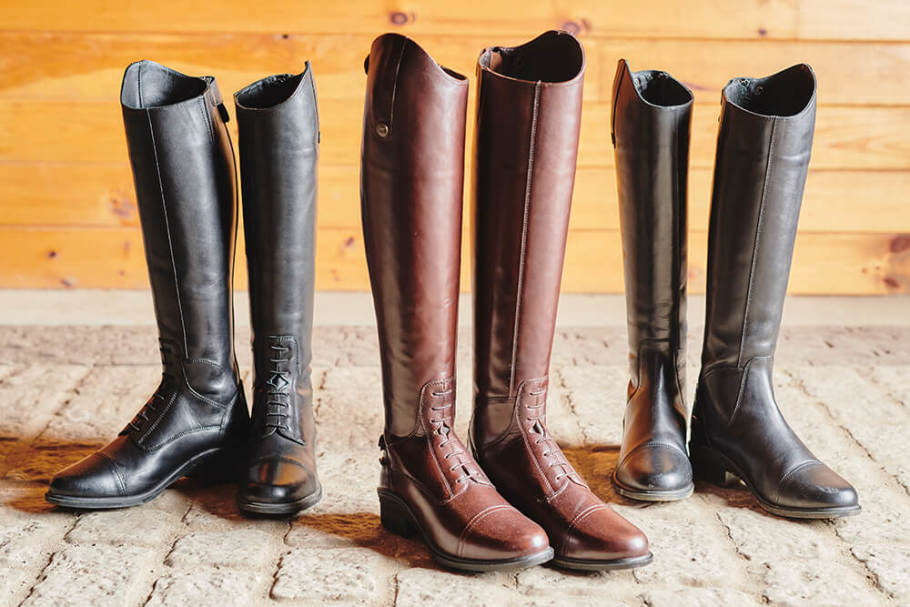
A quintessential staple of the English equestrian’s wardrobe, tall riding boots are one of the most important elements of your riding uniform. A quality pair will help solidify your leg position, improve your balance, and ultimately enable you to ride more effectively. Tall boots also create the appearance of an elongated lower leg for a sleek silhouette in the saddle, which can boost your chances of success in the show ring, especially in equitation classes.
With many options available, we’ll help you navigate what type of tall boots would be the best choice for your style of riding and provide tips on how to measure boot height and shaft, and select a size to ensure a perfect fit.
Tall Boots 101
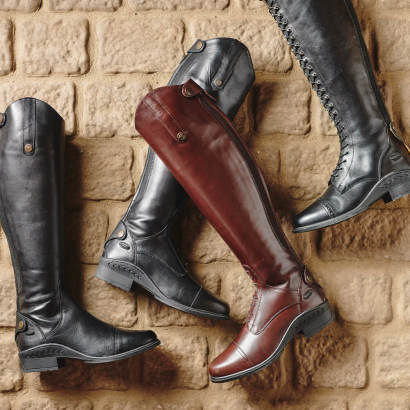
In English equestrian sports, there are three primary types of tall boots:
- field boots
- dress boots
- dressage boots
Each style was developed with specific features to help improve a rider’s performance in a particular discipline. There are also an increasing number of cross-over boots on the market today that combine certain features of all three boot types to give riders who compete in multiple disciplines a selection of options.
Most tall boots are made from leather, although vinyl is commonly used in economy boots, and more technical materials are increasingly being incorporated into boots at all price levels. While black is still the most prevalent color for tall boots and continues to reign supreme in the show ring, brown boots are trending for schooling and fox hunting and are occasionally seen in jumper, dressage, and eventing competition. Custom boots can be made to order in additional colors and a variety of leather textures.
Before the mid-2000s, there weren’t many off-the-shelf tall boots offering a custom-like fit, so many riders—especially those competing at higher levels—opted to splurge on custom-made boots to ensure an ideal fit. However, with recent advances in design, most riders can now find a near-custom fit in an off-the-shelf boot at a much lower price than custom boots. Prices will vary between brands depending on leather quality, style, technical features, and any enhancements developed by a particular manufacturer.
Types of Tall Riding Boots
Field Boots

Named after the calvary field officers who first wore them, field boots are made of soft, supple leather to allow the ankle to flex and the heel to drop when a rider’s leg is in a shorter jumping position. Field boots should be tall (hitting just below the knee), and they should fit closely through the calf and ankle to create the appearance of an elongated leg. Most field boots also have a slightly higher rise on the outer rim called a Spanish cut, which can help a rider’s legs to look even longer.
Traditionally, field boots had “swagger” tabs on the top outside edges that were used to help pull the boots on. However, as zippers were incorporated, manufacturers replaced tabs with other embellishments for a more elegant look. Most modern field boots feature elastic laces across the instep (or vamp) of the boot, elastic panels by the zipper, and many styles have a stitched punched-hole toe cap.
Dress Boots

Like field boots, dress boots fit closely to the rider’s leg and can be made from soft or slightly firmer leather. Dress boots differ from field boots in that they do not have laces across the instep. Hunt boots are a subset of dress boots and are often worn for fox hunting; typically black, their distinguishing feature is a cuff of contrasting leather on the top of the boot.
Dressage Boots
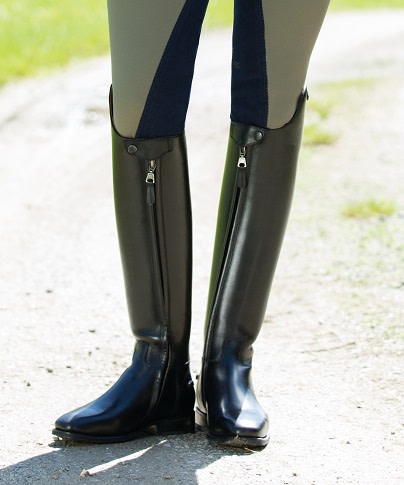
Compared to their tall boot counterparts, dressage boots are crafted out of a stiffer leather, especially along the outside of the boot, and they tend to have a straighter, “stovepipe” fit down the leg. Like dress boots, dressage tall boots do not have laces and are often more rigid except for a small strip of softer leather around the ankle. These riding boots are specifically designed to encourage a longer leg in the saddle and thus are not recommended for jumping or when riding in a half-seat, as they would be quite uncomfortable to ride in with shorter stirrups.
Specialty Tall Riding Boots
Schooling Boots
These boots are worn for everyday riding and typically aren’t appropriate for the show ring. Schooling boots come in array of colors and styles and are usually designed with lightweight, breathable materials that are flexible and often waterproof. Many designs incorporate technical features like sneaker-style footbeds and gripping materials on the inner calf to help keep riders comfortable and improve leg position. Schooling boots are currently more popular in Europe than the U.S.
Winter Boots

For colder climates, there are a wide variety of insulated tall boots. Available in a variety of styles, most winter boots are black and are either made of leather or a combination of technical fabrics with added insulation.
Polo Boots
Typically made of brown leather and designed with a front zipper and/or buckles on the outside of the boot, polo boots are worn with matching knee guards for the sport of polo.
Fox-Hunting Boots
For the more casual cubbing season, brown field boots or black dress boots are a popular option. For the formal fox-hunting season, black dress boots are typically the boot of choice—with men’s boots having a tan or brown cuff at the top and women’s boots having black patent-leather cuffs. It’s always advised to check with your hunt club for specific attire guidelines, as they can vary by organization.
Which Tall Boots are Right for You?

Keep in mind, we recommend you check the most recently published official rule book for any recognized competition you enter to ensure your attire is compliant.
Tall Boots for Hunters or Equitation Riders
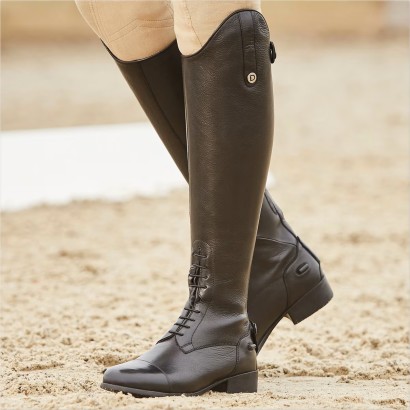
- Preferred boot: Field boots; however, dress boots are becoming more acceptable and increasingly popular for hunt-seat and equitation riders.
- Boot fit: Boots should be as tall as possible without interfering with the rider’s knee, and they should fit snuggly. Many competitors prefer boots with a custom-like look, which fortunately are more readily available in off-the-shelf options than in years past.
- Boot style: Whether you choose field or dress boots, they’re almost always made of traditional polished black leather with minimal embellishments.
Shop Field Boots or Dress Boots for Hunters or Equitation
Tall Boots for Show Jumpers

- Preferred boot: Field or dress boots
- Boot fit: Boots should be as tall as possible without interfering with a rider’s knee, and they should fit quite snuggly. Like hunt-seat and equitation riders, jumpers tend to prefer the custom, tailored look.
- Boot style: While traditional black is still the most prevalent color in the show ring, jumpers are getting bolder with color and sophisticated accents. Contrasting piping, fresh leather colors, and new technical features and materials are currently trending in the jumper ring.
Shop Field Boots or Dress Boots for Jumpers
Tall Boots for Eventing Riders
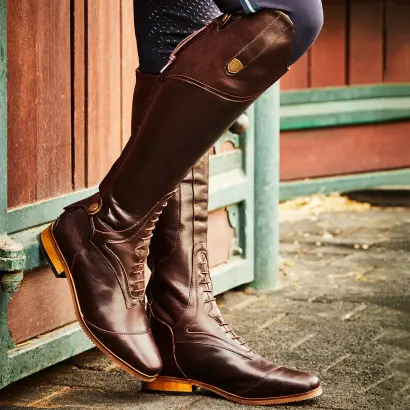
- Preferred boot: Field, dress, and/or dressage boots (for dressage phase). Some eventers change boots depending on the competition phase, while others prefer to wear the same boots for all three phases.
- Boot fit: Depends on the type of tall boot.
- Boot style: Black is still the most prevalent color in the show ring, but like jumpers and dressage, eventers are having fun with contrasting piping, fresh leather colors, technical features, and new materials.
Shop Field, Dress, or Dressage Boots for Eventers
Tall Boots for Dressage Riders

- Preferred boot: Dressage or dress boots; field boots are acceptable at lower levels of competition.
- Boot fit: Boots should fit as tall as possible for an elegant look without interfering with a rider’s knee and tend to be fitted through the upper calf. Dressage boots have a straighter, stovetop fit through the calf through the ankle.
- Boot style: While traditional black is still the most prevalent color in the dressage ring, competitors are getting bolder with color and flair. As with almost all dressage tack and rider apparel, touches of bling, shiny patent leather, and fancy designs are common (we’ve even spotted some gorgeous dark blue dressage boots in the show ring).
Shop Field, Dress, or Dressage Boots for Dressage Riders
How to Measure for Tall Boots
What You’ll Need to Measure Yourself for Tall Boots
- Cloth tape measure
- Chair
- Your regular breeches and socks
- Friend (to help you measure correctly)
Step-by-Step How to Measure for Tall Boots
- Suit up in the breeches and socks you plan to wear under your tall boots.
- In a seated position with your knees bent at a 90-degree angle, have your friend measure the widest part of your calf with the tape measure. This will provide your calf measurement.
- Next, have your friend measure from your heel up to the bend at the back of your knee to determine your boot height measurement.
How to Tell if Your Tall Boots Fit Properly
Footbed Size
This should correspond with your regular shoe size, although certain brands may run slightly large or small. Some tall boots are sold in European sizes, so be sure to carefully read the size conversation chart provided by the manufacturer.
When trying on tall boots, ensure your feet feel comfortable in the footbeds; there should be plenty of room for your toes and your heels should rest comfortably without lifting. Tall boots generally have narrow footbeds; if you have a wider foot and the boots feel snug across the instep, try using a boot stretch spray to encourage the leather to relax and stretch across the width of your foot.
Boot Calf Fit

Calf fit is largely based on personal preference and your discipline. Field and dress boots tend to fit closer through the calves. It’s important, however, to keep in mind that the leather will stretch to some degree once you’ve broken in the boots. If you’re in between sizes and prefer a snugger fit, you should probably size down. If you prefer a more relaxed fit or are prone to weight fluctuations, it might be best to size up.
Boot Height Fit

There are several important considerations to bear in mind when selecting your boot height. As you break in new boots, the leather around the ankle will stretch and soften causing the overall height of the boot to slightly shorten over time. This decrease in height is referred to as the “expected drop” and can range from a few centimeters to a few inches depending on the boots’ structure. It’s crucial to factor in this drop when choosing a boot height otherwise the boots may be too short once they’re broken in.
Boots should be as tall as possible to achieve that elongated lower-leg look. Tall boots that are too short will break up that long line, creating a less-flattering profile in the saddle. Boots that are too short can also be a safety hazard if they were to catch on the flap of your saddle. If you’re in between sizes, most manufacturers advise sizing up. You can use heel lifts to alleviate rubbing behind your knees while you’re breaking in your boots.
Keep in mind that tall boot sizing charts list the boot height before they drop, but most manufacturers include the boots’ expected drop in their product descriptions to help customers select the appropriate height. If, for example, your boot height measures 18 inches and the boots’ expected drop is one inch, you’ll want to purchase 19-inch-tall boots.
Examples of Tall Boots that Don’t Fit Quite Right
Let’s walk through a couple of examples of improper fit in tall boots.

As you can see in this example, the boot is too short and wide through the calf. There is enough room for her to fit her whole hand inside the top of the boot. It shifts around excessively and will hinder the rider in achieving an effective leg position.

In this example, the boot is too tall. They won't drop enough to alleviate the discomfort behind the knee, and they will cause excessive wrinkling around the knee.
New tall boots, whether they are your first pair or your 20th, are an exciting purchase. If you need help deciding between brands, give us a call and one of our knowledgeable Product Specialists will be happy to answer any questions and help you pick out the perfect tall boot!
Shop Our Selection of Tall Boots